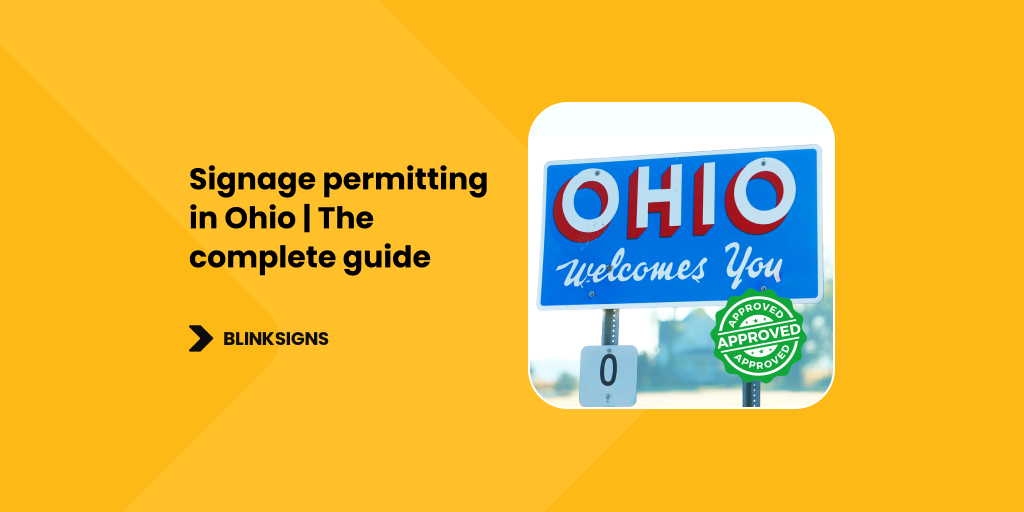
Signage permitting in Ohio | Sign permit services solutions
Signage in Ohio’s cities and towns, from Cleveland’s busy streets to Cincinnati’s charming districts, is essential for attracting customers and establishing brand identity. Each town in Ohio, whether Columbus, Toledo, or Akron, has unique rules surrounding signage; signage permitting in Ohio state often requires careful navigation of municipal codes, zoning ordinances, and state-wide guidelines from the Ohio Department of Transportation (ODOT).
For businesses, effective signage can enhance visibility, reinforce brand presence, and comply with local aesthetics while meeting essential safety standards. At BlinkSigns, we know that every sign tells a story, and we’re here to guide Ohio businesses in meeting signage permit requirements that not only elevate their message but also ensure compliance with state laws and local zoning restrictions.
Types of Signage Permitting in Ohio
Ohio’s varied landscape and zoning needs mean that different sign types are subject to distinct regulations, whether in downtown Columbus, along Toledo’s highways, or within the historic districts of Cincinnati. Commonly permitted signs include freestanding signs, which mark property boundaries and welcome visitors; wall signs, which identify storefronts; and projecting signs, often used in art districts like Short North in Columbus.
Digital displays, including Electronic Message Centers (EMCs), are prominent in Dayton’s skyline but are carefully regulated for brightness and illumination to avoid distracting drivers. Temporary signs, including banners or signs for seasonal events at places like Cedar Point, typically require short-term permits to maintain Ohio’s clean visual standards. Each city enforces specific setback requirements, sign size limits, and restrictions on sign areas based on its unique character, ensuring every sign complements the community.
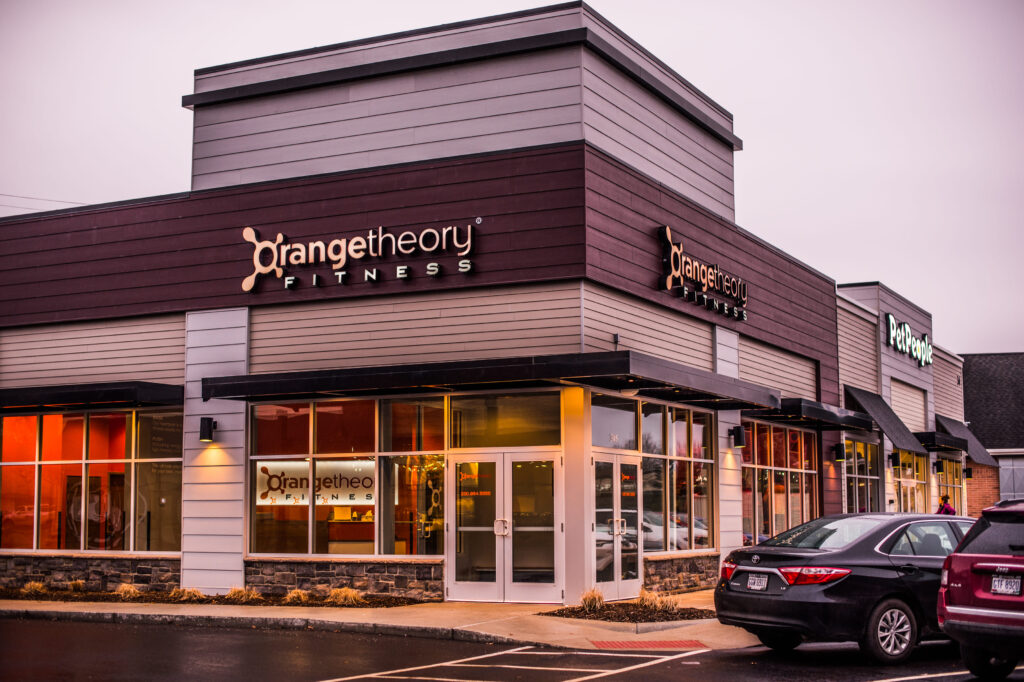
OrangeTheory Fitness ohio
State-Level Regulations: Ohio’s Overarching Rules
While Ohio’s cities impose local codes, overarching rules from the Ohio Department of Transportation (ODOT) govern signage on highways and major roadways, ensuring safe and effective communication. Regulations stipulate size limitations based on road types, sign spacing to prevent clutter, and illumination standards to protect drivers from potential distractions. Ohio’s sign code also addresses content, especially for off-premise signs such as billboards, requiring that ads align with public safety standards and avoid prohibited content.
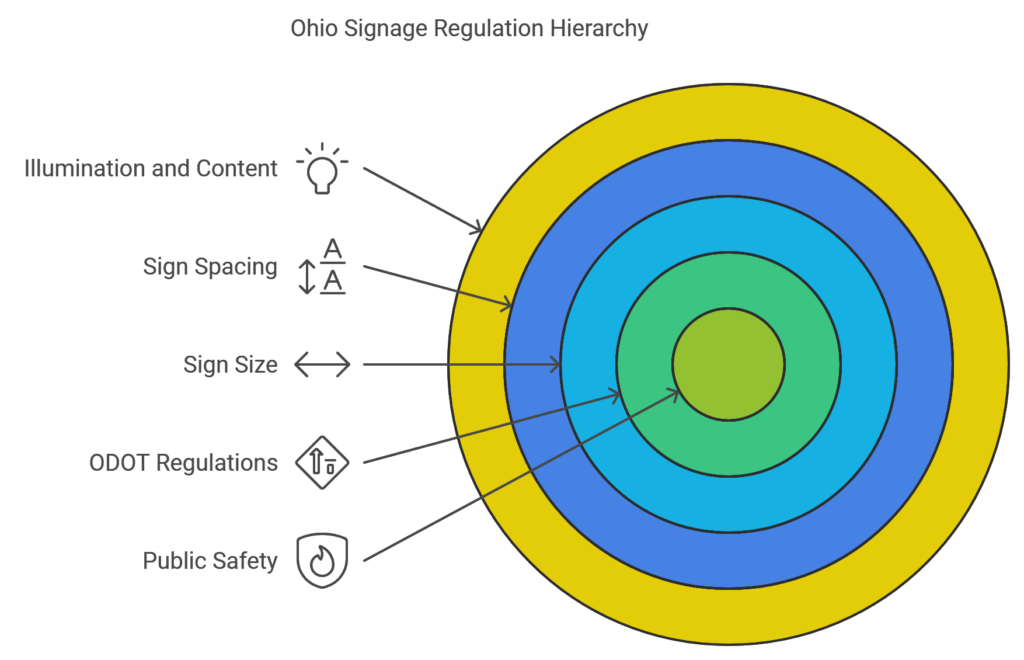
Ohio Signage Regulation Hierarchy
Compliance with ODOT’s regulations is crucial for businesses such as I-75 in Toledo or Route 33 in Athens, where visibility is key, but safety cannot be compromised. BlinkSigns ensures that your signage meets local and state guidelines, making your message clear and compliant across Ohio.
Local Permitting Process: Navigating Municipal Mazes
The permitting process varies widely across Ohio’s cities, with each municipality enforcing specific procedures tailored to local zoning ordinances and aesthetic preferences. Typically, the process involves researching zoning codes, preparing detailed plans and elevation drawings, and submitting an application to the city’s building or zoning department. Each city’s permit issuance process may include site plan reviews and involve interactions with multiple entities, such as architectural review boards for historic districts in areas like Marietta or Tremont.
Larger cities, including Columbus and Cincinnati, often have complex, multi-step processes, while smaller towns might offer more streamlined procedures. BlinkSigns leverages local expertise and strong relationships with permitting officials across Ohio, ensuring smoother navigation through these varied processes and efficient approval of signage projects.
Permitting Fees: Investing in Your Visual Identity
Ohio’s permitting fees reflect the state’s economic diversity, with costs influenced by sign type, size, location, and electrical components. For example, freestanding signs in downtown districts like Columbus’s business hub may incur higher fees due to prime real estate values. In contrast, wall signs in smaller cities may be more affordable. Illuminated signs, especially those using LED or neon lighting, often require additional permits for electrical components. Fees are also higher in historic areas to maintain Ohio’s aesthetic standards.
For instance, a wall sign in Akron may cost around $100, but a high-tech digital display in Cleveland can cost several thousand dollars. BlinkSigns helps you budget for these fees across Ohio’s cities, from Chagrin Falls to Toledo, so that you can make an informed investment in your brand’s visual identity.
Common Restrictions: Keeping Ohio Beautiful
Ohio’s restrictions on signage vary widely to preserve the beauty of its unique environments, from Hocking County’s scenic hills to Columbus’s urban architecture. Common restrictions include size and height limits for signs, with sign height regulations often based on zoning district specifications to protect visibility and harmony within the community. Illumination is regulated near residential zones to minimize light pollution, especially for digital signs and Electronic Message Centers (EMCs).
Restrictions are in place in historic districts to preserve character and integrity, as seen in Cincinnati’s Over-the-Rhine or Columbus’s German Village, where traditional, non-intrusive signage is favoured.
BlinkSigns ensures your sign complies with these nuanced restrictions, creating signs that respect Ohio’s diverse communities while maximizing brand impact.
Special Considerations for Specific Sign Types
Certain sign types face unique regulatory challenges in Ohio. For example, digital displays and EMCs in cities like Cleveland are subject to specific brightness and animation restrictions to prevent driver distraction. Temporary signs, including banners or A-frames, are generally limited in duration and size, especially for seasonal promotions or grand openings. Projecting signs in historical districts like those in Lebanon or Worthington must align with architectural styles. At the same time, billboards near scenic byways like the Ohio River Scenic Byway face strict size and location regulations.
Murals, frequently governed by public art ordinances in places like Cincinnati’s ArtWorks program, are subject to review to ensure they meet aesthetic and legal standards. BlinkSigns navigates these challenges by designing signage that meets Ohio’s diverse regulatory standards and enhances the local environment.
Consequences of Non-Compliance: Avoiding Pitfalls
Ignoring Ohio’s signage regulations can lead to severe consequences, from fines to the forced removal of non-compliant signs. Local code enforcement officers closely monitor compliance with municipal codes, often imposing fines that can escalate depending on the offense. Non-compliant signage can also affect a business’s operating license, with certain cities, like Cleveland and Cincinnati, known for strictly enforcing sign code violations. Fines can be significant, particularly for oversized signs or digital displays in restricted zones.
Beyond financial penalties, non-compliance can damage a business’s reputation within the community, particularly in sensitive areas like German Village, where local character is highly valued. BlinkSigns’ proactive approach ensures that your signage is designed and installed to comply with Ohio’s complex regulations, protecting your investment and public image.
Tips for Successful Permitting: BlinkSigns’ Insider Strategies
Navigating Ohio’s signage permitting process requires a strategic approach. BlinkSigns recommends starting the permit application early, as the process may take several weeks in larger cities. Thorough research into each locality’s specific codes, from Akron’s industrial zones to Zanesville’s commercial areas, is essential. Establishing a solid relationship with local permitting officials can help resolve issues and expedite approvals. Preparing to make design adjustments is also beneficial, particularly in historic districts like Marietta, which have high aesthetic standards.
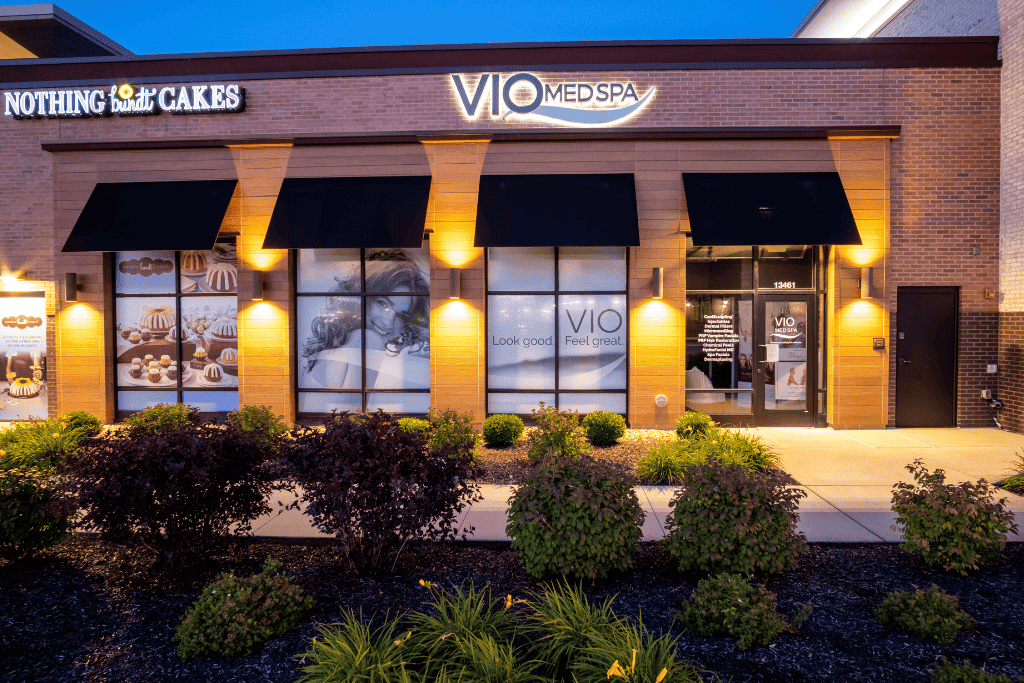
VIOmed Spa Ohio
Documenting all communication and submissions is another best practice to track progress. Our experienced team at BlinkSigns leverages these strategies to ensure your project progresses smoothly, whether it’s a tech-centric sign for Dublin’s Bridge Park or a traditional sign for an Amish Country business.
Ohio Sign Permitting Requirements by Category
| Category | Description | Examples | Key Requirements |
| Sign Types | Categories of signs, each with distinct permitting needs | Freestanding, Wall, Projecting, Digital Displays | Size, placement, and illumination standards specific to each type |
| Location & Zoning | Restrictions based on the sign’s location and surrounding zones | Commercial, Residential, and Historic Districts | Compliance with zoning ordinances and specific regulations in historic areas |
| Application Requirements | Documents and specifications required for permit applications | Site Plans, Elevation Drawings, Electrical Permits | Submission of design details, structural drawings, and electrical specs |
| Lighting & Illumination | Standards for brightness and light emission to reduce distractions | LED, Neon, EMC | Compliance with illumination standards, especially near residential areas |
| Structural Standards | Structural Standards | Compliance with structural guidelines to ensure durability and safety | Sign Structure, Wind Load, Foundation Specifications |
| Size & Measurement | Regulations on maximum sign dimensions, including height and width | Height Limit, Square Footage, Clearance | Compliance with maximum dimensions based on location and zoning type |
| Permitting Process | Steps for application, approval, and inspection | Application Submission, Plan Review, Inspections | Includes submission, local review, compliance checks, and final approval |
| Prohibited Signs | Types of signs are generally restricted to preserve safety and aesthetics | Flashing, Obscene, Animated Signs | Restrictions on flashing lights, excessive animation, or inappropriate content |
| Variance & Appeals | Exceptions and appeals for non-standard signage | Variance Request, Zoning Board Approval | Required for signage that exceeds standard limitations or local codes |
| State Highway Regulations | Rules for signage along highways enforced by ODOT | Off-Premise Signs, Billboards, Scenic Byways | Compliance with ODOT guidelines, scenic byway restrictions, and spacing limits |
Future Trends in Ohio Signage Regulations
Ohio’s signage regulations are evolving in response to technological advances and community priorities. Cities like Columbus and Cleveland are increasingly adapting smart signage options, integrating interactive elements to enhance customer experience and connectivity. Sustainable signage practices, such as using eco-friendly materials and energy-efficient lighting like LEDs, are gaining popularity in municipalities like Toledo and Cincinnati, reflecting a push towards environmentally conscious business operations.
Additionally, aesthetic considerations are expanding, with cities emphasizing signage that complements local architectural styles, as seen in Dayton’s aviation-inspired neighborhoods and Athens’ academic surroundings. BlinkSigns keeps a finger on the pulse of these developments, helping your business stay ahead of trends with compliant and forward-thinking signage solutions.
BlinkSigns’ Comprehensive Permitting Services
BlinkSigns offers a full suite of permitting services to streamline your signage project from concept to installation. Our process begins with an in-depth consultation, analyzing your needs against local regulations from Cleveland’s waterfront districts to Cincinnati’s hilltop neighborhoods. Our design team crafts signage that aligns with brand identity while meeting local aesthetic and dimensional requirements.
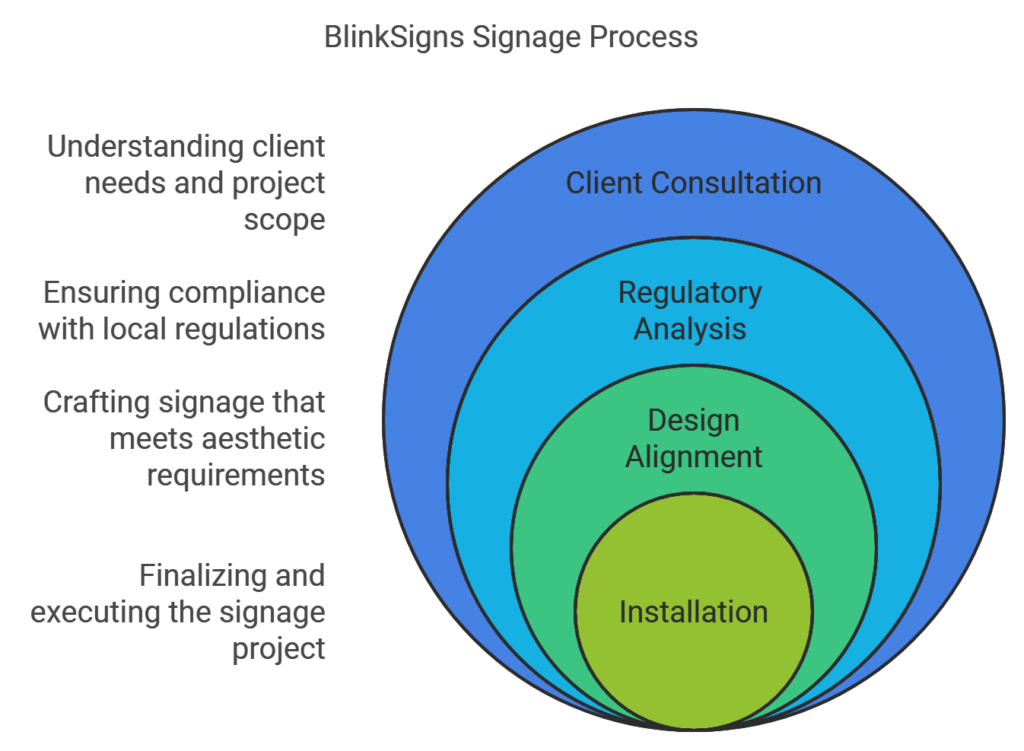
Blinksign`s signage process
BlinkSigns then manages every documentation aspect, ensuring compliance with each city’s requirements, from site plans to electrical permits. We also handle all submissions and follow-ups with permitting authorities and are prepared to revise designs if necessary or appeal permit denials. Our installation coordination ensures that each sign is set up to meet structural integrity standards and visibility requirements.
With BlinkSigns as your partner, navigating Ohio’s regulatory landscape becomes simple. Whether your business is located in the vibrant streets of Columbus or the quiet suburbs of Toledo, we bring your vision to life while ensuring compliance with every regulation in the Buckeye State.
City-Specific Signage Permitting in Ohio
Cleveland: Signage Permits in the Rock and Roll Capital
In Cleveland, signage permitting is overseen by the Cleveland City Planning Commission and the Department of Building and Housing. Cleveland enforces strict zoning ordinances for signage, especially in districts like Playhouse Square and Tremont, where aesthetic alignment with historic and cultural elements is prioritized. The Graphics Code outlines specific requirements based on zoning categories, impacting both commercial and residential areas.
- Size and Placement: Cleveland has size restrictions on wall and freestanding signs, with detailed setback requirements that differ by neighborhood.
- Illumination Rules: LED and neon signs must comply with brightness standards to avoid disrupting residential zones.
- Special District Approvals: In areas like Ohio City or University Circle, the Landmarks Commission may require additional approval for signage that aligns with the historical character.
With BlinkSigns, navigating Cleveland’s unique regulations becomes more manageable, ensuring your business’s signage complements the cityscape while adhering to all city requirements.
Columbus: The Capital City’s Comprehensive Permitting Process
Columbus has a well-defined signage permitting process managed by the Department of Building and Zoning Services. The city has distinct signage codes for districts like the Short North Arts District and German Village, which maintain strict aesthetic guidelines to preserve neighborhood integrity.
- Zoning Codes and Graphics Code: Columbus’s Graphics Code categorizes signs by type (on-premise, off-premise) and zoning, establishing specific limitations on sign area and height in both commercial and residential zones.
- Historic Area Compliance: Businesses must submit applications to the Historic Resources Commission for design approval in areas like German Village.
- Digital Signage: To reduce driver distractions, brightness controls, dwell times, and message transitions restrict digital signage and electronic message centers (EMCs).
With BlinkSigns, Columbus businesses can secure permits that respect the city’s diverse character, from modern hubs like Easton Town Center to historic districts.
Cincinnati: Permitting in the Queen City
In Cincinnati, the Department of City Planning and Buildings manages signage permits, with distinct regulations for neighborhoods like Over-the-Rhine and Mount Adams. Cincinnati’s zoning rules emphasize historical preservation, especially in heritage-rich areas, and restrict certain types of illuminated signage to prevent visual clutter.
- Permitting for Historic Districts: Business owners in districts like Over-the-Rhine must obtain additional approval from the Historic Conservation Board to ensure signage reflects neighborhood aesthetics.
- Height and Setback Rules: Cincinnati enforces stringent height and setback regulations to protect the city’s skyline and neighborhood views.
- Illumination and EMCs: EMCs and digital displays are limited in brightness, particularly near residential areas or mixed-use zones, and require specific electrical permits.
BlinkSigns assists Cincinnati businesses in aligning their signage with Queen City’s vibrant, historic landscape, ensuring compliance while maximizing visibility.
Toledo: Signage Regulations Along the Maumee River
Toledo’s signage permitting process is governed by the Division of Building Inspection within the Department of Economic and Business Development. With scenic views along the Maumee River, Toledo has unique requirements for signs visible from scenic routes and historic areas.
- On-Premise and Off-Premise Signs: Toledo enforces clear distinctions between on-premise signs, which advertise businesses on the same property, and off-premise signs, such as billboards, which are highly regulated.
- Size and Spacing Standards: The city limits sign area and spacing along major routes like I-75, ensuring signs don’t obstruct natural views.
- Temporary Signage: Temporary signage, including banners, must meet placement and duration limits to prevent clutter in public spaces.
With BlinkSigns, Toledo businesses benefit from tailored signage strategies that align with the city’s focus on environmental preservation and safe advertising practices.
Dayton: Compliance for the Birthplace of Aviation
In Dayton, the Division of Planning and Community Development oversees signage regulations, emphasizing the preservation of the aesthetic and historical elements of its aviation heritage. Specific codes govern signage in Dayton’s commercial and residential areas, with additional scrutiny on digital signage.
- Zoning and Size Requirements: Dayton’s zoning regulations vary based on location, with different restrictions for areas like the Oregon District, where smaller, traditional signage is favored.
- Digital and EMC Regulations: Digital signs and Electronic Message Centers (EMCs) are subject to brightness and animation limits, ensuring they do not interfere with Dayton’s residential neighborhoods.
- Historic District Approvals: The Landmarks Commission evaluates sign designs within Dayton’s historical areas to preserve the character of iconic neighborhoods.
BlinkSigns ensures Dayton businesses meet all necessary requirements, allowing them to celebrate their brand within the guidelines of Ohio’s birthplace of aviation.
Akron: The Rubber City’s Signage Standards
In Akron, the Zoning and Building Standards Division manages signage permitting, strongly focusing on preserving neighborhood character and ensuring public safety. Akron’s regulations cover both permanent and temporary signage, particularly in bustling areas like Downtown Akron.
- Height and Setback Limitations: Akron enforces height restrictions and setback requirements to prevent signage interference in high-traffic areas and pedestrian zones.
- Digital Signage Controls: Illuminated signs and EMCs must adhere to brightness controls, especially in residential areas.
- Temporary Signage and Banner Permits: Akron restricts temporary signage to specific timeframes to ensure that banners or promotional signs do not detract from the city’s aesthetic.
BlinkSigns aids Akron businesses in navigating local ordinances and ensuring signage contributes positively to the city’s identity and business growth.
Key Permitting Standards by City
| City | Permitting Authority | Common Requirements | Unique Considerations |
| Cleveland | City Planning Commission, Dept. of Building & Housing | Sign size, height, and placement must adhere to strict zoning ordinances | Landmarks Commission approval is required for historic districts |
| Columbus | Dept. of Building & Zoning Services | Graphics Code determines zoning-based sign size and height | Historic Resources Commission approval for signs in historic districts |
| Cincinnati | Dept. of City Planning and Buildings | Strict height and setback limits protect views in scenic zones | Historic Conservation Board approval is required in areas like Over-the-Rhine |
| Toledo | Division of Building Inspection | On-premise and off-premise signs must meet size and spacing standards | Unique guidelines for signs near scenic routes along the Maumee River |
| Dayton | Division of Planning and Community Dev. | Specific zoning requirements for each district | Landmarks Commission reviews for signage in historic neighborhoods |
| Akron | Zoning and Building Standards Division | Setback requirements and restrictions on temporary signage | Temporary banners limited to specific timeframes in commercial zones |
Frequently Asked Questions About Ohio Signage Permits
Let’s address some common queries about signage permitting in the Buckeye State:
Q: How long does the permitting process typically take?
A: It varies widely, from a few days in smaller towns to several months in larger cities like Columbus or Cincinnati.
Q: Are there any signs that don’t require permits?
A: Small window signs and temporary signs (like “For Sale” signs) generally don’t need permits, but always check local regulations.
Q: Can I appeal if my permit is denied?
A: Yes, most municipalities have an appeals process. Blinksigns can guide you through this.
Q: Do I need separate permits for electrical work on illuminated signs?
A: Often, yes. Cities like Cleveland and Toledo typically require electrical and signage permits.
Q: How do historic district regulations affect signage?
A: Historic districts, like those in German Village or Over-the-Rhine, often have stricter design guidelines to preserve character.
At Blinksigns, we’re always ready to answer your questions and guide you through Ohio’s diverse permitting landscape.
Conclusion: Partnering with BlinkSigns for Seamless Permitting Across Ohio
Ohio’s cities each carry distinctive permitting requirements, with differences in zoning regulations, sign size restrictions, and review procedures for historic districts. Understanding each city’s unique signage code is essential for businesses aiming to achieve impactful and compliant signage in Ohio. BlinkSigns simplifies this process by managing every aspect of your signage project, from initial design aligned with local aesthetic requirements to managing approvals from historic boards or planning commissions.
Whether you’re looking to install a digital display in Cleveland, a classic wall sign in Cincinnati, or a projecting sign in Columbus’s arts districts, BlinkSigns ensures that your signage aligns with each city’s standards while representing your brand effectively. With BlinkSigns as your trusted partner, you’ll navigate Ohio’s permitting requirements with ease, letting your business shine in Ohio’s vibrant communities.
Let BlinkSigns guide your business through Ohio’s unique signage landscape, from the shores of Lake Erie to the neighborhoods along the Ohio River. Contact us today at Sales@blinksigns.com or +1 877-433-4466 to discover how we make signage compliance straightforward across Buckeye State.